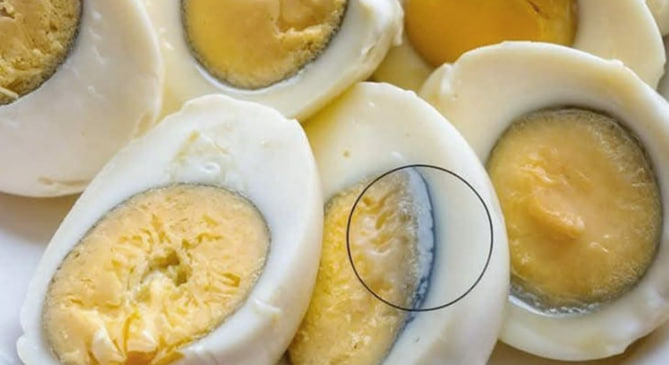Hard-boiled eggs are a popular choice for salads, snacks, and meal prep. However, many people notice a greenish-gray ring forming around the yolk after cooking. While this ring may seem unappetizing, it is completely harmless and easily avoidable. This article explains why the green ring forms, what it actually is, and how to cook hard-boiled eggs perfectly every time.

What Causes the Green Ring in Hard-Boiled Eggs?
The green ring that sometimes appears around the yolk of a hard-boiled egg is the result of a natural chemical reaction. When eggs are overcooked, the iron in the yolk reacts with the sulfur in the egg white. This reaction forms iron sulfide, which creates the green or grayish ring around the yolk.
This reaction is well documented in food science literature. According to the United States Department of Agriculture (USDA), the discoloration does not indicate spoilage or poor quality. It is simply a harmless result of overcooking.
Source: United States Department of Agriculture (USDA) Food Safety and Inspection Service
https://www.fsis.usda.gov
Is the Green Ring Safe to Eat?
Yes, the green ring is safe. While it may not look appealing, iron sulfide is nontoxic. The egg remains fully edible. The main issue is aesthetic—people often find the color unappealing, especially when serving eggs in salads or as garnishes.
How to Prevent the Green Ring in Hard-Boiled Eggs
Preventing the green ring is easy with a few simple adjustments to your cooking method. Here’s a step-by-step, evidence-based approach to achieving perfectly cooked hard-boiled eggs:
1. Start with Cold Water
Place eggs in a single layer in a saucepan. Add cold water to the pan until the eggs are covered by about 2 to 5 centimeters of water. Starting with cold water ensures even heating and reduces the chance of cracking.
Food scientists recommend starting cold to prevent thermal shock and to ensure gradual temperature increase.
Source: Harold McGee, On Food and Cooking
2. Heat Gradually and Avoid Rapid Boiling
Bring the water to a gentle boil over medium heat. Avoid a hard, rolling boil, which can cause eggs to crack and can also lead to overcooking.
As soon as the water reaches a visible boil, turn off the heat immediately.
3. Let Eggs Sit in Hot Water
Cover the pan with a lid. Let the eggs sit in the hot water, off the heat, for the following times:
-
9 minutes for slightly softer yolks
-
12 minutes for fully firm yolks
These times are recommended by the USDA and other culinary experts to avoid overcooking while ensuring food safety.
Source: USDA Egg Cooking Guidelines
https://www.fsis.usda.gov
4. Cool Quickly in Ice Water
Once the cooking time is over, immediately transfer the eggs to a bowl of ice water. Let them sit in the ice bath for at least 5 minutes.
This rapid cooling step:
-
Stops the cooking process immediately
-
Prevents the formation of the green ring
-
Makes peeling easier
The National Center for Home Food Preservation notes that rapid cooling is essential for maintaining egg quality.
Source: https://nchfp.uga.edu
5. Peel Under Running Cold Water
After cooling, gently crack the shell and peel the egg under running cold water. The water helps separate the membrane from the white, making peeling easier.
Additional Tips for Perfect Hard-Boiled Eggs
Use Slightly Older Eggs
Very fresh eggs are harder to peel after boiling. Eggs that are 5 to 10 days old peel more easily because the pH of the white changes slightly with age.
Source: American Egg Board
https://www.incredibleegg.org
Add Salt or Vinegar to the Water
Adding a teaspoon of salt or a splash of vinegar to the cooking water can:
-
Help prevent cracking
-
Make shells easier to peel
Salt increases the boiling point slightly and vinegar can help coagulate any whites that leak if a shell cracks.
Storage Recommendations
-
In-shell hard-boiled eggs: Store in the refrigerator for up to one week.
-
Peeled hard-boiled eggs: Best if eaten within 2 to 3 days for optimal quality and food safety.
Source: USDA Food Safety and Inspection Service
https://www.fsis.usda.gov
Why It Matters: Simple Steps for Better Results
Avoiding the green ring is less about advanced culinary skills and more about simple timing and cooling practices. By following the recommended steps—gentle heating, controlled resting, and rapid cooling—home cooks can consistently produce hard-boiled eggs with bright, attractive yolks free from the greenish ring.
These small adjustments make a significant difference in presentation and enjoyment. Whether you’re making egg salad, deviled eggs, or simply enjoying them as a snack, these tips ensure your eggs look as good as they taste.
Conclusion
The green ring around hard-boiled egg yolks is a common and harmless result of overcooking, caused by a reaction between iron and sulfur that forms iron sulfide. It is safe to eat but can be prevented with proper cooking techniques.
By starting with cold water, avoiding overboiling, letting eggs rest in hot water for the right time, and cooling them quickly in an ice bath, you can achieve perfectly cooked eggs with bright yellow yolks. These simple, science-backed tips help home cooks avoid frustration and serve beautiful, delicious hard-boiled eggs every time.

Sources
-
United States Department of Agriculture (USDA) Food Safety and Inspection Service. “Shell Eggs from Farm to Table.” https://www.fsis.usda.gov
-
National Center for Home Food Preservation. “Eggs.” https://nchfp.uga.edu
-
American Egg Board. “Eggcyclopedia: Hard-Cooked Eggs.” https://www.incredibleegg.org
-
McGee, Harold. On Food and Cooking: The Science and Lore of the Kitchen. Scribner, 2004.

